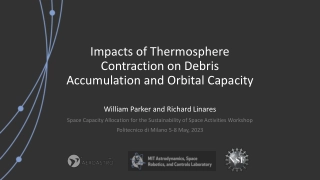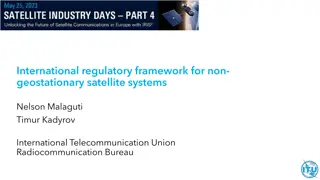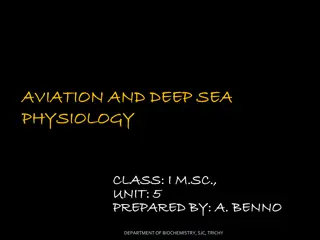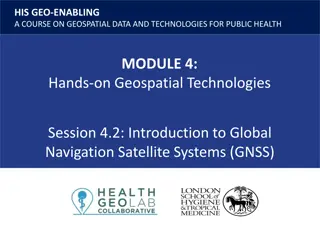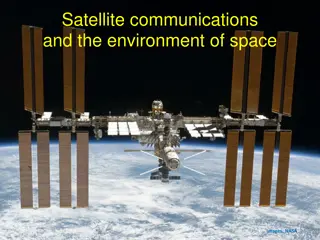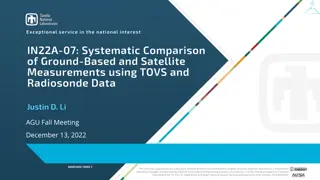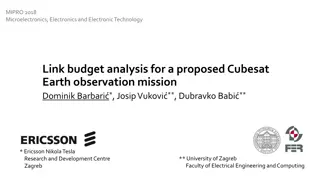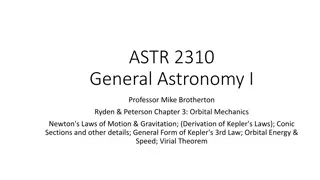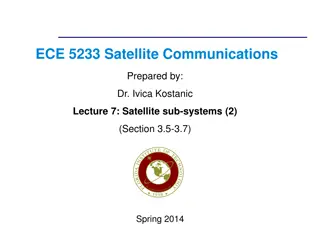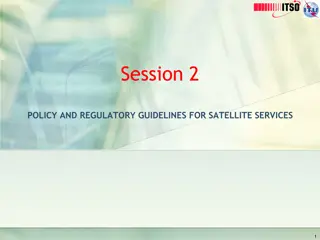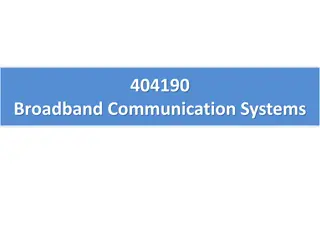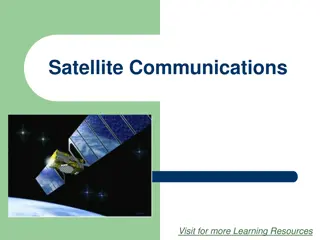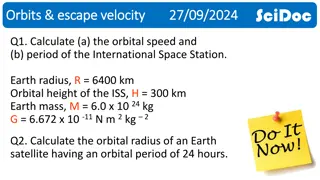Understanding Orbital Altitudes and Satellite Services
Explore the fascinating realm of orbital altitudes and satellite services, including the differences between Low Earth Orbit (LEO) and Geostationary Earth Orbit (GEO). Learn about the physics behind satellite trajectories and how services like Starlink and Skymuster provide unique communication solutions in Eastern Australia.
Download Presentation

Please find below an Image/Link to download the presentation.
The content on the website is provided AS IS for your information and personal use only. It may not be sold, licensed, or shared on other websites without obtaining consent from the author. Download presentation by click this link. If you encounter any issues during the download, it is possible that the publisher has removed the file from their server.
E N D
Presentation Transcript
LEOs and GEOs Geoff Huston APNIC
LEOs in the News screenshot from starwatch app Screenshot - https://www.theverge.com/2022/8/25/23320722/spacex-starlink-t-mobile-satellite-internet-mobile-messaging Screenshot: https://asia.nikkei.com/Business/Telecommunication/Elon-Musk-s-Starlink-launches-satellite-internet-service-in-Japan
Newtonian Physics If you fire a projectile with a speed greater than 11.2Km/sec it will not fall back to earth, and instead head away from earth never to return On the other hand if you incline the aiming trajectory and fire it at the critical speed it will settle into an orbit around the earth The higher the altitude the lower the orbital speed
Leos Geos https://commons.wikimedia.org/wiki/File:Orbitalaltitudes.jpg GNU Free Documentation License
Geostationary Earth Orbit At an altitude of 35,786km a satellite will orbit the earth with the same period as the earth s rotation from the earth it will appear to be stationary in the sky https://commons.wikimedia.org/wiki/File:Communications_satellite_with_TEMPO_spacecraft_model.png public domain https://secure.boeingimages.com/archive/Commercial-Communications-Satellites-Orbit-2F3XC5KQCM9.html
Low Earth Orbit https://commons.wikimedia.org/wiki/File:Orbitalaltitudes.jpg GNU Free Documentation License
Low Earth Orbit LEO satellites are stations between 160km and 2,000km in altitude. The objective is to keep the satellite s orbit high enough to stop it slowing down by grazing the denser parts of the earth s ionosphere, but not so high that it loses the radiation protection afforded by the Inner Van Allen belt. At a height of 550km, the minimum signal propagation delay to reach the satellite and back is 3.7ms. Image - spacex screenshot from starwatch app
Measuring LEO and GEO services Eastern Australia has both LEO and GEO services available Which provided us with a unique opportunity to test the LEO and GEO services with the same endpoints Starlink LEO service Skymuster GEO service
Test Regime We ll use 3 different TCP congestion control algorithms: Reno, Cubic and BBR We ll compare three different access regimes: fibre, GEO (AUSsat) and LEO (Starlink) We used an Intel NUC running Debian 10, and iperf3 to load the circuits
Terrestrial Fibre Australian NBN FTTP service with a 275/25 Mbps access rate Server and client are some 1,000km apart Ping test: IPv6 average 21.5ms IPv4 average 20.5ms
Fibre 2 Stream Reno Data Rate (MBPS)
Protocol Performance over Fibre All three congestion control algorithms are well behaved in this simple test Reno and BBR equilibrate to a 50/50 share when 2 sessions are active, while Cubic stabilises at a 60/40 split BBR operates with very small queue pressure, and stabilises at wire speed very quickly
GEO Service sold as a 45Mbps service Ping profile
Protocol Performance over a GEO circuit While the ping times are relatively stable, the extended RTT time pushes the congestion protocol into areas of instability this is likely due to the presence of deep queues in this product, in conjunction with the high delay of the path Both Reno and Cubic drop into instability after some 60 seconds. It is unclear whether this is protocol breakdown, or the impact of cross traffic on the tested flows within the GEO system BBR operates remarkably efficiently across this system, driving the link to the delivered capacity without the build up of a standing queue - clearly BBR out-performs Reno and Cubic in this context
Would a TCP accelerator help when using a GEO service? Yes and No!
Would a TCP accelerator help when using a GEO service? Yes and No! If the sender has insufficient internal buffer space to store a delay x bandwidth product of data in its local store then the sender will be buffer-limited when sending bulk data in this case the addition of a network unit that essentially provides additional buffer space will help But if the sender has sufficient local buffer space than the network unit will have no effect
Starlink LEO service https://satellitemap.space/
Starlink LEO service 3,200 in-service operational spacecraft, operating at an altitude of 550km https://satellitemap.space/
Starlink LEO service 3,200 operational spacecraft, operating at an altitude of 550km One-way signal propagation time to reach the spacecraft varies between 1.8ms and 3.6ms (equivalent RTT of 7.3ms to 14.6ms) But that s not what we see: 2000 packets transmitted, 1991 received, 0.45% packet loss, time 2009903ms rtt min/avg/max/mdev = 37.284/60.560/214.301/13.549 ms
Starlink RTT Ping Times We are seeing: 12ms terrestrial component, 7ms/14ms propagation component, 30ms for codec/fec/switching
Starlink 2 Stream Reno Relatively unimpressive performance. There appears to be imposed packet loss events that hampers Reno inflating the sending rate
Starlink 2 Stream Cubic Also unimpressive performance. Cubic appears to be more stable than Reno, but still fails to open up its sending rate over time, so the higher stability is achieved at a cost of lower overall throughput
Starlink 2 Stream BBR BBR seems to be better positioned to extract performance from a variable platform in loss and jitter terms- it is able to operate 3 5 times the speed of Cubic or Reno between the same endpoints The packet loss rate is higher than expected, and this may be an outcome of the combination of using phase array antennae that are tracking satellites that are moving through the sky at a relative speed of 1 degree of elevation every 15 seconds, together with the need to perform satellite handover at regular intervals.
Observations from this data LEO services should clearly out-perform a GEO service but the results are not so clearly differentiated The GEO services appear to operate with a highly level of stability which tend to allow the loss-based TCP protocols to operate efficiently even with the extended delay The LEO services have a far more responsive feedback loop due to the lower RTT BBR is still clearly a better flow algorithm than loss-based TCP in this space: this applies to Fibre, LEO and GEO! Don t throw away your terrestrial fibre! Capacity, stability and protocol performance on fibre-based system are clearly better than satellite paths, if they are available and suit your needs
More measurements needed Is iperf3 on Linux the right measurement tool? Can we bypass the Linux kernel baggage and measure the raw TCP protocol performance? Would using QUIC provide a different view of protocol performance? How do LEO services compare to 5G? Speed vs stability? Should a LEO service expose the underlying jitter and loss to the application, or should it integrate smoothing, and even basic retranmission into the service at the cost of a higher delay overhead?
Does it scale? Fibre well yes, just bury more cable! Geo not really Geostationary spacecraft are normally separated by 2 3 degrees or arc, so there are some 120 180 viable slots. The radio frequencies are also limited to the C, Ku and Ka bands. The on-craft transponders are not steerable so the capacity is provided to a pre- designed footprint Leo unclear, but probably not LEO constellations use low altitude eccentric orbits so the number of space craft in a constellation is determined by the inter-craft distance, horizontally and vertically. Starlink plan for 12,000 craft, Kuiper (Amazon) place for 3,200, Telesat 188, IRTU filings indicate China is planning a constellation with 13,000 craft There is an issue with space junk at LEO orbits. Any collision will generate more junk, and the risk of a runaway effect is high if the altitude slots are densely packed
What about Starlink V2? These satellites are larger, heavier and operate at a higher power level More bandwidth available, and high achievable data speeds Incorporate 5G cellular services Intended to use inter-satellite laser connectors to support packet routing across satellites details sparse so far




